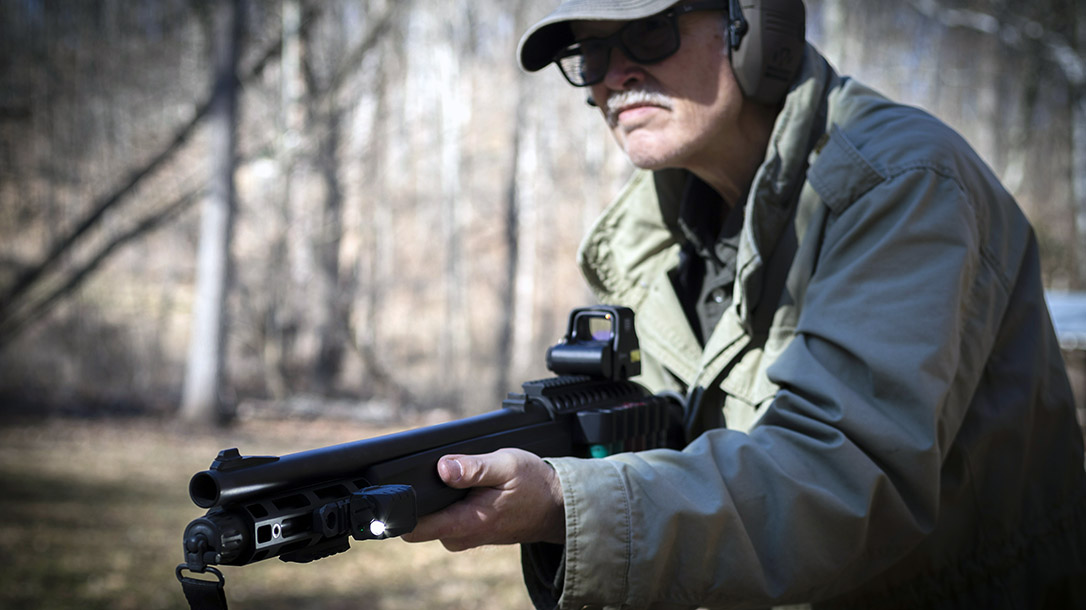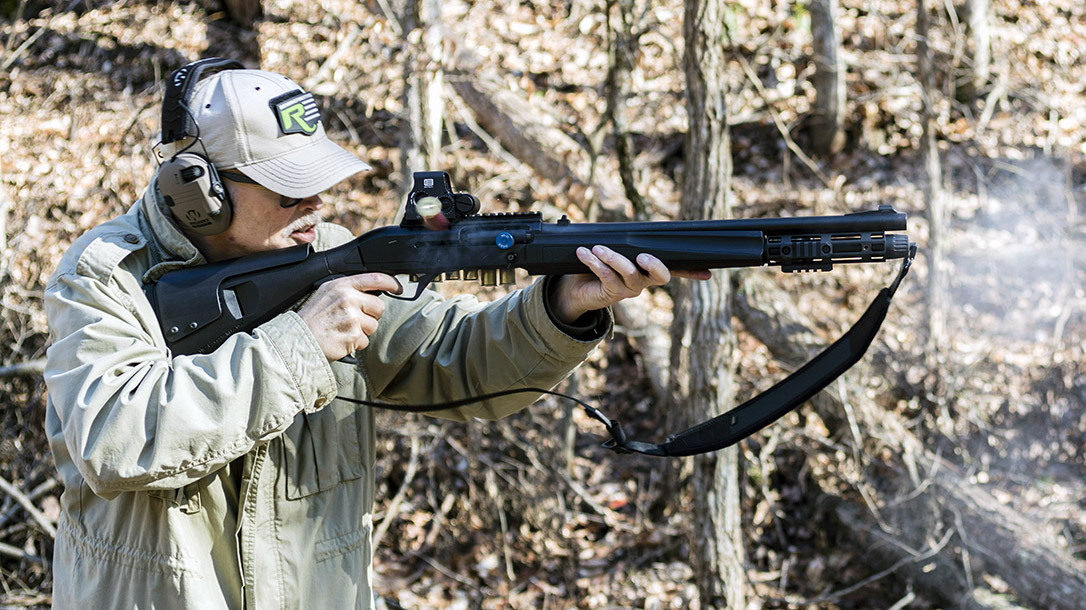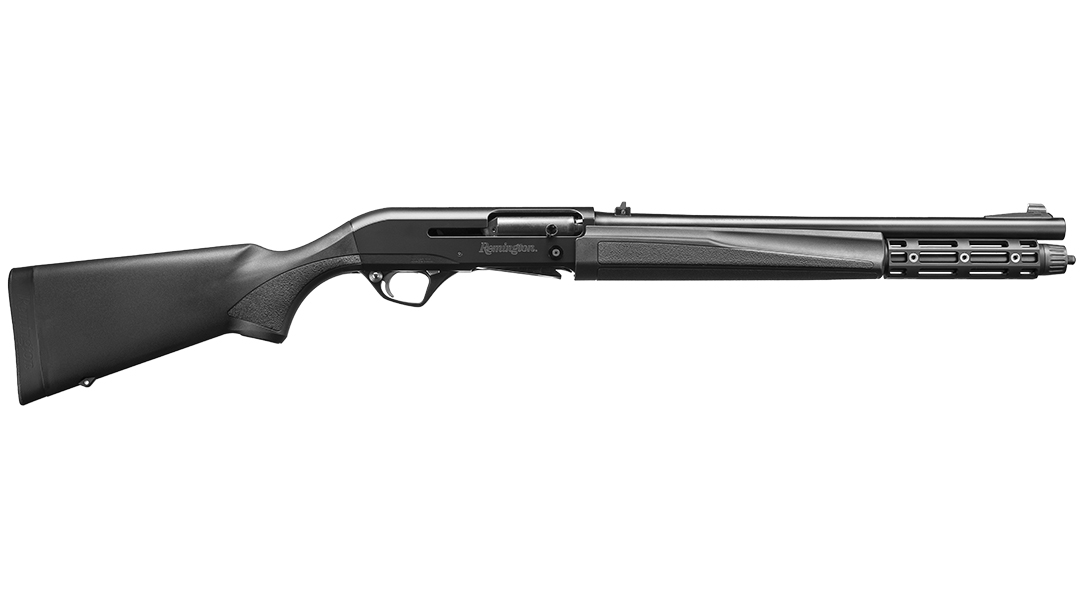I’m a dyed-in-the-wool believer in pump-action shotguns. One sits behind my bedroom door at this very moment. Remington’s reputation in the law enforcement world was built on the Model 870 pump gun, and it’s still out there doing yeoman service with cops and legally armed citizens. However, over the years, semi-automatic shotguns have become just about as reliable as pump actions and are seeing increased usage. A lot of this has to do with the ammunition. With the perfection of plastic-hulled shells in state-of-the-art loadings, there’s no longer a requisite for manual operation.
Remington Versa Max R12
I recently got a chance to handle a number of new weapons at a Remington Defense media event, including the 12-gauge Versa Max R12 shotgun, a spin-off of the company’s popular hunting and target-shooting autoloaders. The heart of the action is the Versaport dual gas piston system, which is self-regulating; the length of the shotshell actually determines the amount of gas pressure utilized for functioning. The R12 will accept and run with anything from 2¾-inch target loads all the way up to 3-inch hunting shells.
Advertisement — Continue Reading Below
Up to eight gas ports located in the bottom of the barrel chamber are exposed depending on the length of the shell. A 3-inch shell will expose three gas ports while a 2¾-inch shell will open up all eight. The gas from the burning shotshell powder is directed into two cylinders outside the barrel, situated at about the 4 and 8 o’clock positions. Piston rods in the cylinders actuate the bolt as they’re propelled backwards by the gases to power the action. This action has proven itself reliable during testing with thousands of shells of differing power levels. There’s an added benefit of substantial recoil reduction, making the shotgun feel more like a 20 gauge.
Remington Versa Max R12 Features
Externally, the R12 is a very no-nonsense “black gun” with a matte finish on all of its exposed metal surfaces, with the exception of a silver-colored trigger and stainless bolt head. The buttstock and forend are synthetic. The former has an overmolded, textured pistol grip and recoil pad while the forend is overmolded with textured panels on the sides and bottom. The tapered barrel is 18 inches long with an improved-cylinder choke. The front sight has a white bead mounted in a dovetail on a sloping ramp. The rear sight is a fixed, express-style unit.
Jutting from the front of the forend, the tubular magazine holds six 2¾-inch shells or five 3-inch shells. Mounted around the exposed portion of the magazine is a ventilated aluminum cover that allows you to mount accessories on the sides and bottom. The cap on the magazine tube also has a stud for a sling swivel, as does the toe of the buttstock.
Advertisement — Continue Reading Below
The aluminum alloy receiver is drilled and tapped for optics or rail mounting. The charging handle and bolt release button are both oversized, just like the triggerguard and crossbolt safety, for rapid operation while wearing gloves.
Tactical Add-Ons
When I received the R12 for some personal testing back home, my first task was examining it, and I found that Remington deserves an “A” for its craftsmanship here. My sample R12 had an excellent fit and finish.
But I wanted to trick out the shotgun with a few sighting options and aftermarket goodies to increase its versatility. Step one was to replace the factory buttstock with a synthetic Urbino stock from Mesa Tactical, which features a pistol grip with a Santoprene rubber insert, an adjustable cheek riser, a LimbSaver recoil pad and multiple sling-attachment options. Designed for military and law enforcement use, the Urbino reduces the length of pull from 14.75 inches to 12.5 inches for both quick handling and when body armor or load-bearing gear is being worn.
Advertisement — Continue Reading Below
Next, I added a Rhino Rib sling from Butler Creek. This sling is made of black nylon with a thick shoulder pad for comfort, “Ultra-Grip” material under the strap to prevent slippage and Uncle Mike’s QD Super Swivels. I also replaced the factory charging handle with a larger, snap-on version from GG&G. Dehorned for safety with a ’Merica Blue end cap, this replacement makes it easier to run the gun in close quarters.
Accessorizing the Remington Versa Max R12
Since I wanted to add an optic, I once again turned to Mesa Tactical for a SureShell carrier and rail. Made from hardcoat anodized aluminum, the SureShell I chose carried six extra shells on the left side, and the Picatinny rail attaches via the drilled and tapped holes on top of the receiver. A rubber friction-retention device also ensures your shells will stay in place until needed.
After installing the carrier/rail, I then added an EOTech XPS2 Green Holographic Weapon Sight (HWS). At just 9 ounces, this HWS has an integral mount for a 1-inch Weaver or Picatinny rail, runs on one CR123 lithium battery for up to 600 hours of continuous use, is submersible for up to 10 feet and has a protective cover surrounding the lens area. Rubber-covered buttons at the rear activate the sight and adjust the circle-and-dot reticle’s brightness. Knobs on the right side allow you to adjust the elevation and windage.
Advertisement — Continue Reading Below
Finally, for close-range use or positions that make it impossible to use the iron sights, I installed a Crimson Trace Rail Master Pro on the left side of the mag tube cover using a short rail. This powerful device adds little weight but offers a 100-lumen LED light and a Class 3R green laser with two hours of continuous illumination. It’s powered by one CR2 lithium battery and shuts off automatically if it isn’t moved for five minutes.
Making Thunder
Given this shotgun’s potential defensive and hunting uses, I decided to test it with a wide variety of shotshells and slugs. I ended up with eight different rounds from Federal, Hornady, Remington and Winchester. My test protocol was based on years of shooting and being a law enforcement firearms trainer for some 17 years. The slug shooting was limited to 25 yards because this is what the average, mostly untrained shooter can handle with any degree of accuracy in a defensive scenario. This same test criteria were used on all the other shooting exercises, too.
Shooting from a bench and using a sandbag for a rest, the R12’s best slug group came with the Remington Slugger rounds, which measured 1.38 inches. Second place went to the Federal TruBall slugs with a cluster measuring 1.79 inches. The Winchester 3-inch slugs were big on recoil but still grouped well. And I didn’t have any hiccups with any of the slugs.
Advertisement — Continue Reading Below
Just to see what the slugs would do out of the R12 at 50 yards, I put up a large target at that distance and fired one slug from each manufacturer. Given that the EOTech was zeroed for 25 yards, I held for the center of the target and my hits were about 6 to 9 inches low. But the holes in the target could be covered with one hand; the group measured just 5.71 inches.
Using black 21-by-31-inch Styrofoam boards set 15 yards away, my tightest shot pattern came in at 4.03 inches with Federal’s copper-plated 00 buckshot. The runner up was Hornady’s Critical Defense ammo with a 4.79-inch cluster. At 25 yards, I peppered the boards with four different shells, and the 00 and #4 pellets left a pattern measuring 9.39 inches—all within the confines of a silhouette target.
Downrange Testing
For a more practical test, I set up a B-27 silhouette and placed markers at 5, 15, 25 and 50 yards, then loaded the R12’s mag tube and SureShell carrier with a mix of 2¾-inch slugs. I carried the shotgun muzzle-up using the sling to the 5-yard marker. At the “go” signal, I unslung the shotgun and simultaneously activated the Crimson Trace light/laser.
Advertisement — Continue Reading Below
I fired two shots into the center-mass of the target rapidly, then moved back towards cover, engaging again somewhere between 5 and 15 yards. Given the scenario, I had to stop in the open at 15 yards, move laterally and fire two more shots. Then I backed up to a tree at 25 yards, took cover and emerged to fire two more rounds. Reacquiring cover, I loaded three slugs from the carrier and engaged the “bad guy” with two center-mass shots and one headshot. Now it was time to move back to another tree at 50 yards, where I fired my final three shots, all center-mass.
Checking the results of my practical exercise, all but five buckshot pellets stayed in the 14-by-19-inch B-27 target center. Those five shots, however, remained within the confines of the silhouette. There were no strays. My headshot with the slug hit the very crown of the head, and the wad hit the right side of the head. The slug and wad holes were all in the 9-, 10- and X-rings of the target. Pellet strikes were in the X-, 10-, 9-, 8- and 7-rings with one hit just outside the 7-ring.
Advertisement — Continue Reading Below
Rapid Fire
My final evaluation at the range was a reliability test of sorts. I loaded the Remington with a mix of shotshells and slugs, activated the Crimson Trace Rail Master Pro, put the green laser dot on a soda can on the ground and ripped off seven shots as quickly as possible. I did this twice and didn’t experience a single malfunction. The R12’s Versaport system certainly reduced the felt recoil and allowed for better rapid-fire control. I came away very impressed with this new Remington autoloader.
For more information, visit remington.com.
Remington Versa Max R12 Specifications
- Gauge: 12; 3-inch chamber
- Barrel: 18 inches
- Overall Length: 39.5 inches
- Overall Weight: 6.4 pounds (empty)
- Stock: Synthetic
- Sights: Low-profile rifle
- Action: Semi-auto
- Finish: Matte black
- Capacity: 6+1
- MSRP: $1,456
Remington Versa Max R12 Performance
Shotshell: Pattern
Advertisement — Continue Reading Below
- Federal #5/6/7 3rd Degree: 13.21
- Federal 00 Personal Defense: 4.03
- Hornady 00 Critical Defense: 4.79
- Remington #4 Ultimate Defense: 7.18
- Winchester 00 Ranger LE: 5.72
Slug: Accuracy
- Federal Vital-Shok TruBall: 1.79
- Remington Slugger: 1.38
- Winchester Super-X: 2.51
Shot pattern in inches at 15 yards and slug accuracy for best three-shot groups at 25 yards.
This article is from the June-July 2019 issue of Tactical Life magazine. Grab your copy at OutdoorGroupStore.com. For digital editions, visit Amazon.


























